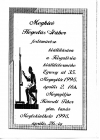GÁBOR HEGEDŰS, painter (1933 – 2021.)
Gábor Hegedűs (who signed his works as “HEGE") was born in 1933 in Miskolc, Hungary. His father worked as a maintenance crew foreman in the mines in the region, so after qualifying as a machine technician, he was employed at a mining office as a draftsman. His talent for drawing was noticed there, and he was sent to study further in Budapest. After completing his matriculation exams, he began to study painting at the Hungarian College of Fine Arts (today the Hungarian University of Fine Arts), under Aurél Bernáth.
In the autumn of 1956, he left the country along with several of his classmates.
He settled in Paris and graduated at the Académie des Beaux Arts. After his graduation, he continued to maintain contact with Ákos Szabó, another student of Bernáth’s who had settled in Paris, as well as László Lakner, who had emigrated to Germany.
It was at the Académie that he met the love of his life who later became his wife and the mother of his daughter. Her French aristocratic family disowned his wife for marrying a destitute Eastern European refugee. They lived an extremely frugal life in Paris. Hegedűs worked as a draftsman and a potter, and also showed his work at smaller galleries, but they could not make a living out of his paintings.
The ongoing existential struggle finally led to a breakdown. Hegedűs needed hospital treatment and had no other choice but to return to Hungary at the end of 1968. The works from his 13 years in France were lost and never recovered.
He returned to Kazincbarcika and lived and worked there until 2014 living with his new spouse, Márta Gross, the daughter of András Gross. During the 1970’s and ’80’s he participated in the work of local and regional art studios and group exhibitions. His paintings were shown in Hungary, Poland, Germany and Czechoslovakia. For a number of years he was also deeply interested in photography. He only used black and white film, and the photos he always developed himself featured portraits, buildings and natural scenes often shown from unusual angles to emphasise the essential features that he found important. He also showed his work at photo exhibitions and even won some awards during that time.
Sadly, the mainstream Hungarian arts community never accepted him. As the years passed, he and his partner increasingly suffered medical problems and their financial situation also deteriorated. Arts dealers and galleries bought up most of his oeuvre for a pittance.
After the death of his partner in 2014, her niece in Budapest with whom they had maintained close relations in previous decades moved him to Budapest as a family member and helped him throughout the rest of his life. He found a wonderful, welcoming community at the Hungarian Evangelical Fellowship. After he passed away, the Fellowship’s leading minister, Gábor Iványi, placed his urn in the Wall of Reconciliation as a mark of respect.
During the last 7 years of his life he was a member of Hungary’s National Association of Creative Artists, he was active in the arts life of Budapest’s 3rd district, took part in national and local exhibitions and also had two solo exhibitions.
August 2021
Compiled by Kata Vég, the niece of Márta Gross
Gábor Hegedűs (who signed his works as “HEGE") was born in 1933 in Miskolc, Hungary. His father worked as a maintenance crew foreman in the mines in the region, so after qualifying as a machine technician, he was employed at a mining office as a draftsman. His talent for drawing was noticed there, and he was sent to study further in Budapest. After completing his matriculation exams, he began to study painting at the Hungarian College of Fine Arts (today the Hungarian University of Fine Arts), under Aurél Bernáth.
In the autumn of 1956, he left the country along with several of his classmates.
He settled in Paris and graduated at the Académie des Beaux Arts. After his graduation, he continued to maintain contact with Ákos Szabó, another student of Bernáth’s who had settled in Paris, as well as László Lakner, who had emigrated to Germany.
It was at the Académie that he met the love of his life who later became his wife and the mother of his daughter. Her French aristocratic family disowned his wife for marrying a destitute Eastern European refugee. They lived an extremely frugal life in Paris. Hegedűs worked as a draftsman and a potter, and also showed his work at smaller galleries, but they could not make a living out of his paintings.
The ongoing existential struggle finally led to a breakdown. Hegedűs needed hospital treatment and had no other choice but to return to Hungary at the end of 1968. The works from his 13 years in France were lost and never recovered.
He returned to Kazincbarcika and lived and worked there until 2014 living with his new spouse, Márta Gross, the daughter of András Gross. During the 1970’s and ’80’s he participated in the work of local and regional art studios and group exhibitions. His paintings were shown in Hungary, Poland, Germany and Czechoslovakia. For a number of years he was also deeply interested in photography. He only used black and white film, and the photos he always developed himself featured portraits, buildings and natural scenes often shown from unusual angles to emphasise the essential features that he found important. He also showed his work at photo exhibitions and even won some awards during that time.
Sadly, the mainstream Hungarian arts community never accepted him. As the years passed, he and his partner increasingly suffered medical problems and their financial situation also deteriorated. Arts dealers and galleries bought up most of his oeuvre for a pittance.
After the death of his partner in 2014, her niece in Budapest with whom they had maintained close relations in previous decades moved him to Budapest as a family member and helped him throughout the rest of his life. He found a wonderful, welcoming community at the Hungarian Evangelical Fellowship. After he passed away, the Fellowship’s leading minister, Gábor Iványi, placed his urn in the Wall of Reconciliation as a mark of respect.
During the last 7 years of his life he was a member of Hungary’s National Association of Creative Artists, he was active in the arts life of Budapest’s 3rd district, took part in national and local exhibitions and also had two solo exhibitions.
August 2021
Compiled by Kata Vég, the niece of Márta Gross
Thumbnail view:

































